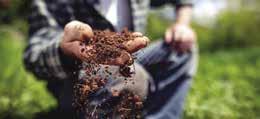
3 minute read
IT’S A DIRTY BUSINESS
from 55+ Living Spring 21
by 55+ Life
How to prepare your soil to guarantee your garden’s success
BY CARI SCRIBNER
Advertisement
The time has come at last to roll up your sleeves and get out the trowel to herald spring with the season’s greatest gift: a bountiful garden.
Whether you’re planting butter leaf lettuce or fragrant begonias, nurturing plants from seeds or buying sprouted seedlings from the plant nursery, a flourishing garden takes more than water and sunlight. It also takes what lies beneath: hearty soil rich in nutrients with the right PH level.
To help you get your garden off on the right foot, we’ve unearthed the top six tips for preparing your soil for successful planting.
1Find a new spot to plant. “Using the same area for gardening depletes some of the nutrients in the soil,” said Jacklyn Older, manager at Hewitt’s Garden Center in Saratoga Springs. 2Have your soil tested (see sidebar). Plants need around 20 nutrients for healthy growth, said Susan Beebe, assistant director of agriculture at Saratoga County Cornell Cooperative Extension in Ballston Spa. These range from potassium to calcium to sulfur. 3Understand the importance of soil pH. This is a measurement of the alkalinity or acidity of soil.. Soil pH is measured on a scale of 1 to 14, with 6.5 to 7 as the sweet spot. Acid soils have a pH below 7 and alkaline soils are above 7. If your pH levels

How to Take a Soil Sample
1. When should soil be sampled?
Samples can be taken at any time during the year, but try to avoid extremely wet soil conditions. 2. How often should I have my soil tested?
For most gardens, every two to three years. 3. What tool should I use for sampling?
Use a garden spade or shovel. 4. What if I have an area of poor crop growth?
If you have a trouble spot, take and label a separate sample from this area. 5. Should the sample be dry?
Yes. If you dig up wet soil, spread it out on newspaper and let it dry at room temperature. 6. How much soil is needed for each composite sample?
About 2 cups. 7. What information should I write down about the sample?
Note the type of plants you plan to grow, how long the gardening site has been used and the fertilizer you’ve used, if applicable. 8. How long will it take to get test results?
One to two weeks. 9. How much does the test cost?
Around $20. Soil samples can be sent to Cornell Cooperative Extension of Saratoga County, 50 W High St, Ballston Spa, (518) 8858995
Source: Cornell Cooperative Extension of Saratoga County
aren’t somewhere in the middle, both high acid and high alkaline will prevent plants from drawing in the nutrients they need from the soil. Based on the soil test results, a garden center specialist can recommend what to add to get to that mid-range.
4Do a science experiment. Older recommends this technique to see if your soil is mostly clay or sand, both of which can be found across the Capital Region. First, dig up enough dirt to fill a glass jar about halfway, then sift it to remove pebbles. Fill the jar with clean water but leave an inch or two at the top. Shake it up, then leave the jar on a flat surface for about two days. After that time, you can visually see the amount of coarse sand that has settled to the bottom. The clay layer will be on top of the silt. Sandy soil won’t hold onto water long enough for thirsty roots, while clay is difficult for water to penetrate at the surface.
5Add compost to remedy both soil types. Compost will help sandy soil hold more water, and will also break up clay soil for better irrigation. If you don’t have a home composting system, head to the garden center for advice.
6Welcome earthworms. Soil is an ecosystem of its own with many living organisms — including worms, Beebe said. Earthworms are hard workers in garden soils. Their wiggling around in the soil helps create a flow of water and air that’s great for good root development. The fastest way to attract and keep worms in your garden is to add organic material (again, compost), and keep the soil moist.
If all else fails, consider potting your plants. You have more control over the soil in a container than in the ground. You can grow everything from flowers to tomatoes in pots that are decorative as a side benefit.











